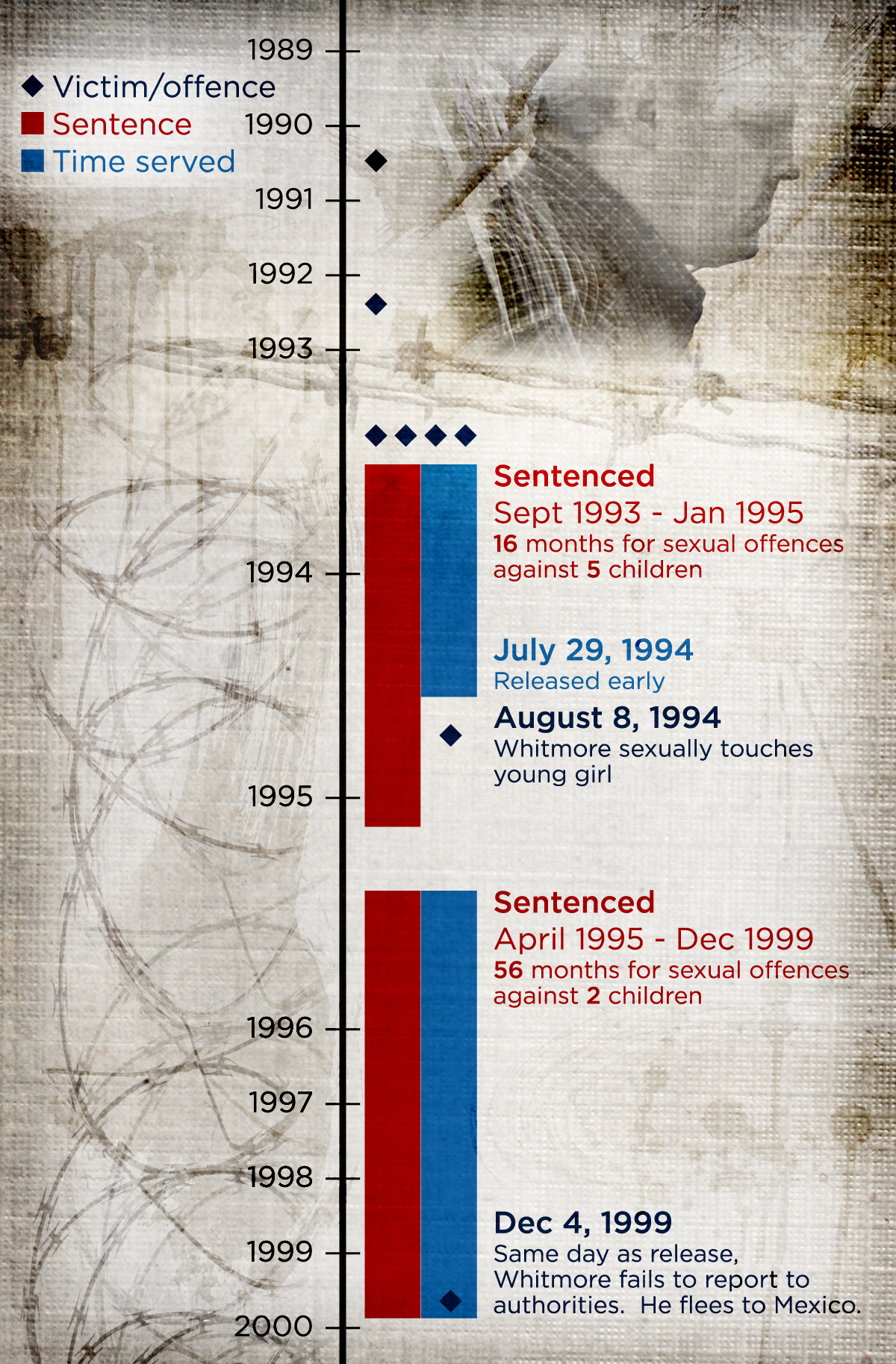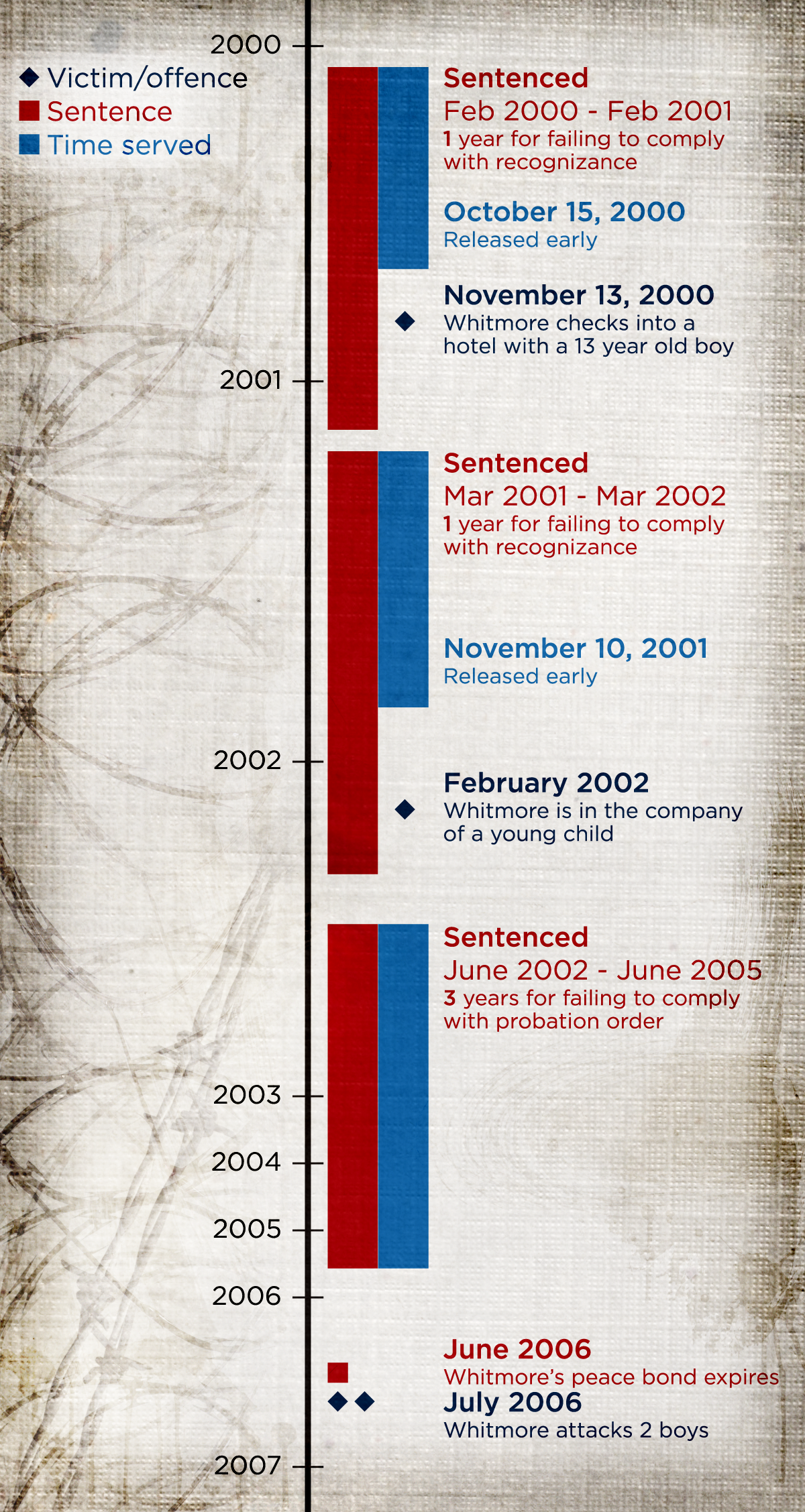One of Canada’s most notorious pedophiles, Peter Whitmore, was released early three times over his criminal history despite a pattern of re-offending and sexual deviancy, documents collected by 16×9 and the Toronto Star show.

Whitmore’s criminal record goes back nearly two decades and shows an escalating list of offences from theft and fraud to kidnapping and sexual assault.
“We knew about this guy a long time ago,” former Parole Board of Canada member John Muise said. “The system could have prevented a lot of victims.”
Whitmore stands convicted for sexual offences against nine children. He is currently serving a life sentence for sexually assaulting two boys in the summer of 2006.
But even before 2006, Whitmore had already been convicted for sexual offences against seven children. 16×9 and the Toronto Star went through Whitmore’s file revealing a file littered with red flags and warnings from the National Parole Board and psychologists.
Whitmore was sentenced for his first set of offences dealing with sexual crimes against children in 1993. He received a 16-month sentence for crimes against five different children which included invitation to sexual touching and sexual interference. He was released early after serving two-thirds of his sentence.
Nine days after his release, he sexually touched an eight-year-old girl. He would be sentenced to 56 months for that crime.
- Posters promoting ‘Steal From Loblaws Day’ are circulating. How did we get here?
- Video shows Ontario police sharing Trudeau’s location with protester, investigation launched
- Canadian food banks are on the brink: ‘This is not a sustainable situation’
- Solar eclipse eye damage: More than 160 cases reported in Ontario, Quebec
By 1995, Whitmore had been convicted of sexual offences against seven children but while in prison, admitted to psychologists he had more victims and guessed the number to be 10 or 11.
Between 2000 and 2001, Whitmore would be convicted twice for breaking the terms of his release for fleeing to Mexico and being in the company of young children. In both cases, he was sentenced to one year and released early.
Then in 2002, while on early release, Whitmore failed to check in by curfew and fled from Toronto to Chilliwack, B.C. Police searched his home and found photos of children, latex gloves, lubricant and zip ties. He was arrested for breaching probation and would serve three years in jail.
Despite years of treatment at various facilities, dozens of reports detail Whitmore’s likelihood to re-offend. Alarmingly, in 2004, the National Parole Board noted clinicians believed Whitmore had a 100 per cent chance of re-offending within seven to 10 years of his release.
In June 2005, while serving the end of a three-year sentence, a performance report warned Whitmore’s “sexual deviance has not been fully addressed and remains a significant risk factor.” That same month he was released from prison and was expected to follow certain conditions.
The issue, Muise says, is the criminal justice system was scrambling “to keep up with this man in order to protect members of society.”
Muise says the biggest problem happened in June 2006 when Whitmore’s recognizance order expired. Whitmore had been living for a year in Chilliwack under conditions outlined in that recognizance order. Documents show that a series of communication failures in the court system allowed the order to expire and Whitmore relocated to Morinville, Alta. Days later Whitmore would kidnap and sexually assault two boys.
Whitmore is currently serving a life sentence for those 2006 crimes and in 2013 he became eligible for parole. So far, Whitmore hasn’t had a parole hearing and there is no guarantee he would be released if he gets one.
READ MORE: Saskatchewan pedophile does not apply for full parole
Some critics maintain his release today would be less likely if he had been given a “dangerous offender” designation. In Whitmore’s case he never received the label and instead of holding a trial, Whitmore accepted a life sentence and pleaded guilty to most of the charges brought against him in 2007.
Muise says the dangerous offender designation is a clear and decisive warning that the offender has committed a serious crime and presents a real threat. In his five years at the Parole Board he never granted release to a dangerous offender.
However, Muise says the Crown is in the best position to decide whether it is smart to proceed with a dangerous offender hearing with a trial that could include testimony by young children or accept a plea agreement.
“Only a judge can give an offender a dangerous offender designation and it is done after a hearing is held where evidence is provided including expert testimony regarding the risk posed now and in the future.”
Muise says there is little difference in terms of parole eligibility between someone with a life sentence and someone given an indeterminate sentence as a dangerous offender. Whitmore ultimately received a life sentence, meaning he could spend the rest of his natural life in prison.
Muise recently returned to his position as director of public safety at the Canadian Centre for Abuse Awareness. Cases like this, he says “should challenge everyone that works in the area of the criminal justice system to always view it through a child protection lens.”
In a joint investigation by 16×9 and the Toronto Star we examine a series of systemic failures by the justice system and sit down for an exclusive interview with one of Whitmore’s victims, Zachary Miller.
“While I Was Gone” airs Saturday, Jan. 23, 2016 at 7pm.
Graphics by Andrew Miller







Comments